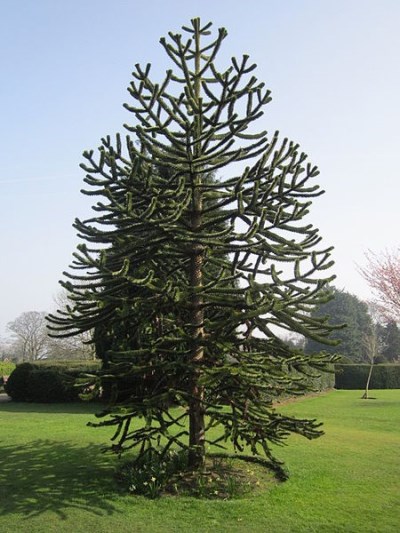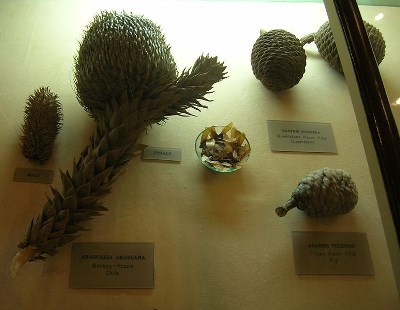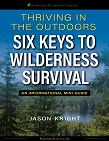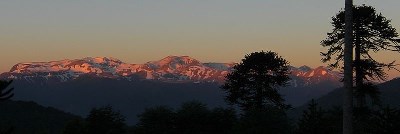The Monkey Puzzle Tree
(Araucaria araucana)

By Chris Byrd
Monkey puzzle trees are becoming an increasing part of the suburban landscape in the Pacific Northwest. People often plant these South American natives for their unique appearance and ability to grow with minimal upkeep in our cool, maritime climate. However, most people remain unaware of their potential for home-scale permaculture as a food source, nor realize the great significance this species has in its native range.
Identification
Monkey puzzles are a coniferous tree with thick bark and limbs in whorls of five. The bark and branches are covered in thick, rigid leaves that are pointed at the tip. When young, it has limbs that reach to near ground level, and has a pyramidal outline when viewed from afar. As the tree ages the lower limbs drop away (around the 100 year mark) and the tree begins to look rather like an umbrella with a long columnar trunk.
Native Ecology
The monkey puzzle tree is a conifer native to the cool maritime climates of Chile and Argentina. In their native range they are mostly found in pure stands, as well as mixed forests, at 1800-5400 feet elevation on south and west facing slopes in areas with abundant rainfall, high humidity, and cool summer temperatures. They favor volcanically derived soils and prefer areas of high sunlight; although they can tolerate (and regenerate) in partial shade.

Ethnobotanical Uses
For the native people living in its range the monkey puzzle was of great significance. The seeds from the tree were a staple food eaten fresh, or stored for later use. The seeds were ground into flour, sun/fire dried, or fermented into a beverage called Chavid. The wood was used occasionally for the construction of homes, but mostly was used as fuelwood since the wood burns long, and extremely hot.
Be More Prepared For Your Next Outdoor Adventure!

Don't leave without knowing these six essential survival skills. Our free survival mini guide reveals the strategies of:
- Shelter & fire to prevent the number one cause of death
- Obtaining clean water to avoid life-threatening dehydration
- Common wild survival foods and other critical skills!

Cultural Significance
The monkey puzzle tree holds a significant place in the culture of the native people’s within its range. For some first peoples the trees are considered extended family members and are collectively managed by multiple family groups. The nut of the tree were used as part of the burial ritual in some native funerals, and at times were planted in native cemeteries. Even today the tree holds a significant place in the culture of the region. The monkey puzzle is the national tree of Chile and it appears in the background of the seal of the Argentine province of Neuquen.

Permaculture Uses of the Monkey Puzzle Tree
Monkey puzzle trees are most often used as landscape trees in suburban neighborhoods and specimen trees in botanical gardens. However, in cool maritime climates it has the potential to be a useful canopy species in edible forest gardens.
Monkey puzzles are low maintenance and produce a nutritious nut crop yearly in the late summer/early fall time period. The trees will produce their first crop at around 40 years of age and will continue producing until the tree hits the 1,000 year mark (or more!). Since the trees are dioecious (some plants are male and some are female) in order to get an edible nut crop you need to make sure to plant one male for every 5-6 female trees. Unfortunately, most monkey puzzles you see planted in the yards of suburban homes will never produce a crop because they are planted singly.
Conclusion
Monkey puzzle trees have become increasingly familiar to residents of the west coast over the last few decades. The increased use of them in landscaping opens up possibilities for expanding the role these amazing plants play in our food production systems, and adds yet another tool in the arsenal of gardeners and permaculturists who wish to create forest gardens that benefit future generations of people in the Pacific Northwest.
By the way, a big part of why we love homesteading & permaculture skills so much is because they are a natural extension of learning about wilderness survival (both fields are all about self-sufficiency and working with nature to satisfy needs). An understanding of survival not only helps you become a better permaculturist, it empowers you with life-saving outdoor skills to keep you safe when out in nature. Right now you can get a free copy of our mini survival guide here, where you'll discover six key strategies for outdoor emergencies, plus often-overlooked survival tips.
References:
1) Aagesen, David, “Burning monkey-puzzle: Native fire ecology and forest management in Northern Patagonia” Journal of Agriculture and human values volume 21 (2004): pages 233-242. Kluwer Academic Publishers.
2) Kitsteiner, J.(2012, Nov.6) Temperate Climate Permaculture [Permaculture Plants: Monkey Puzzle] tcpermaculture.blogspot.com
Learn more about the monkey puzzle tree at the "Plants For A Future" (PFAF) website.
Learn all about useful plants and trees at our Permaculture Courses and Wild Edible & Medicinal Plants Courses.

About the Author: Chris Byrd is an instructor at Alderleaf. He has been teaching naturalist skills for over twenty years. Learn more about Chris Byrd.
Return from Monkey Puzzle back to Permaculture Articles
Is The Essential Wilderness Survival Skills Course Right for You? Take the "Online Survival Training Readiness" Quiz
See for yourself if this eye-opening course is a good fit for you. It takes just a few minutes! Get your Survival Training Readiness Score Now!

Grow Your Outdoor Skills! Get monthly updates on new wilderness skills, upcoming courses, and special opportunities. Join the free Alderleaf eNews and as a welcome gift you'll get a copy of our Mini Survival Guide.

 The Six Keys to Survival:
The Six Keys to Survival:
Get a free copy of our survival mini-guide and monthly tips!
Learn more